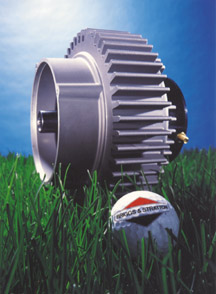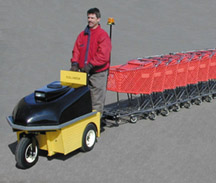Briggs & Stratton Corporation
 Development of electric motor technology has been evolving for
over a century. There are many varieties of motors that have surfaced over
time to fit into an ever-growing number of applications. They essentially
serve to convert electrical energy into rotational motion. Currently,
interest is very high in DC Motor Technology. The objective is to make
electric motors more portable and powerful.
Development of electric motor technology has been evolving for
over a century. There are many varieties of motors that have surfaced over
time to fit into an ever-growing number of applications. They essentially
serve to convert electrical energy into rotational motion. Currently,
interest is very high in DC Motor Technology. The objective is to make
electric motors more portable and powerful.
While improvements have been made in motor materials and manufacturing processes, the basic construction of brushed DC motors remains much the same as it did 100 years ago. A variety of brush manufacturers continue to combine various materials in a process that sometimes appears to be 80 percent science and 20 percent alchemy. The other two major building materials, copper and steel, have seen some improvements in mechanical and electrical properties over the years due to both manufacturing process improvements and additions of alloys. Permanent magnet DC motors have depended on only marginal improvements in ferrite magnet technology.
The typical manufacturing process consists of stacking laminations, inserting a hub, winding or inserting the armature with coated copper wire, attaching a commutator to the armature, assembling a brush card, either winding a stator or creating a stator from permanent magnets and putting all these components into a cylindrical case. Almost all manufactures in the world follow these basic processes.
Lynch Motor Technology
In 1995, Briggs & Stratton Corporation was continuing its investigation of new technologies and one thing was clear, "We were not interested in producing a wire motor similar to those being made by approximately thirteen hundred manufacturers around the world," said Fred Stratton, Chairman and CEO. "We envisioned a new and unique product that could be produced in harmony with our core manufacturing competencies."
Briggs & Stratton contacted manufacturers and inventors across the globe, making visits and testing samples at the Milwaukee headquarters. "We literally searched the world," said John Fiorenza, Director of Business Development at Briggs & Stratton Electrical Products Division. "While we found several individuals and companies working on unique motor constructions, one inventor's approach drew our interest. This ultimately led to Briggs & Stratton licensing the Lynch motor technology."
The inventor, Cedric Lynch, took an unconventional approach to motor construction. The technology has been under development since the early nineties and has been used in a variety of applications. One of the most notable is electric go-carts.
Standard motors use stacks of steel laminations around which copper wire is inserted or wound. What makes the Briggs & Stratton Etek motor technology unique is the use of copper bus bars rather than steel and copper wire as the basic building block of the armature. These copper bus bars are stamped, bent, coated and assembled into a thin rotary disk. End clips connect the tips of the bus bars to shorten the air gap between the magnets. Steel is inserted between the bus bars to shorten the air gap between the magnets. One of the most unique characteristics of the motor is that simply machining the edges of the copper bars produces the commutator. Since commutator is built in, there is no need for a separate assembly.
The motor uses neodymium magnet technology. Neodymium, a rare earth element, provides three times the magnetic force of an equivalent ferrite magnet. While expensive, difficult to manufacture and relatively rare thirty years ago, this technology has developed to the point where it is found in a wide variety of applications including stereo speakers and Harley Davidson motor cycles.
The Results
The resulting motor construction is what conventional technologists would describe as a wave wound axial air gap brushed DC motor. The performance, however, is far from conventional. When compared to an equivalent wire wound DC motor capable of producing similar torque, several advantages are obvious.
The first is that the Briggs & Stratton Etek motor uses one-tenth the steel and one-half the copper as is used in a conventional DC motor. A typical golf car motor weighs approximately 32 to 42 lbs. The Briggs & Stratton Etek motor weighs 22 lbs. This means less turf compaction in the golf car application. For all vehicle applications, it means lower payload and longer run time.
The second advantage is that the Briggs & Stratton motor is one-half the size of a competitive motor. While many designers today think of the motor and controller late in the design cycle, Briggs & Stratton believes that some designers may want to start with the company’s motor size and design around it.
Possibly one of the most significant performance features of the Briggs & Stratton Etek motor is efficiency. While demonstrating high efficiencies under no or small loads, conventional DC motors experience a dramatic drop in efficiency (as low as 70 percent are not uncommon) as they are loaded down. This simply means that nearly a third of the valuable energy in the on-board batteries is going toward producing heat and other unwanted power rather than motion. The Briggs & Stratton Etek motor technology does not use battery energy to produce its electric field in the stator. This is done by the neodymium permanent magnets. The use of copper bus bars gives the motor an extremely low internal resistance, which results in greatly reduced losses.
Columbia Makes Shopping Cart Retrieval Easier With The JAG Cart Puller
Columbia Par Car Corp. released the JAG Cart Puller, its newest electric vehicle designed specifically for retrieving shopping carts. The exclusive design lifts the wheels of the front cart while pulling the line of carts to the building.
"We are the only major industrial vehicle manufacturer in the business of building a vehicle that effectively retrieves shopping carts," states Todd Sauey, president of Columbia ParCar. "We have been building industrial electric vehicles for many years and have a nationwide infrastructure to support this important and growing market," he added.
The JAG Cart Puller uses the Etek 24 Volt DC, totally enclosed permanent magnet motor with axial air gap technology. There are four maintenance free, 6 volt sealed lead acid, deep cycle batteries and an on-board automatic 120 volt / 7.2 amp AC charger.
The drive system has direct coupling to the helical geared transaxle. There is direct steering rod linkage from the steering wheel to the front wheel. Auto-adjust mechanical drum brakes are on each rear wheel, and there is fully integrated electronically controlled regenerative braking. A parking brake is automatically applied upon dismount.
With the ability to carry up to 800 lbs., including operator, cargo and options, the rated speed is 6 mph and 1/2 speed when in reverse. Ground clearance is 4 inches and the vehicle measures 74 inches long, 31 inches wide and 72 inches tall. It weighs 985 lbs. with batteries.

Safety features include stand-up operation, strobe light, safety directional keyswitch, battery status indicator, a horn, reverse warning buzzer, integrated protective rub strip and controlled rollaway with audible alarm. An all-weather compartment provides storage of tow ropes, gloves and other items from the elements. Options include a headlight, hour meter, clipboard holder, covered operator platform and flat-out tire treatment.
Physical stamina and strength are no longer attributes needed to perform the job of cart retrieval. In addition to making cart retrieval easier and safer, retail operators can reallocate payroll to other positions or reduce the total number of hours used in their daily operation.
"The annual savings for some of our customers can be in the millions of dollars when all of their locations are considered," states Columbia representative Bill Grimes. Just as significant is the opportunity to reduce workers compensation claim exposure as well as the property damage caused by runaway or excessive carts on the lot. By using the JAG Cart Puller, retail and wholesale club operators can also reduce their cart inventory at each location and recycle carts much faster.
The Briggs & Stratton Etek motor maintains an efficiency of 88 to 91 percent over a wide range of loads. The benefits to the customer are straightforward. Electric vehicles using the Etek motor have a greater range. Briggs & Stratton performed independent testing on golf cars and found that range was increased 10 to 15 percent. The reason is simple. More of the battery' s energy is used to produce motion rather than heat. One of the other benefits is that for the same amount of usage, a vehicle equipped with the Briggs & Stratton motor will experience reduced battery discharge. This results in reduced energy to recharge the batteries at the end of the day and prolonged battery life due to shallower depth of discharge.
Also significant is that the Etek motor experiences reduced speed droop when it is loaded compared to competitive series wound DC motors. Golfers have experienced this phenomenon when riding up a hill in a golf car: as the car reaches an incline the speed begins to drop. This drop can be 60 percent. The Briggs & Stratton Etek motor loses approximately 10 percent of its speed when it is loaded.
Golf car manufacturers somewhat improve the performance of their series wound vehicles by converting their high end cars to separately excited motors where the motor field current is separately controlled. While this improves hill-climbing performance, it is still short of the performance of the Etek motor system.
Conclusion
The issue facing the technology was cost and high volume manufacturing capability. Briggs & Stratton spent two years industrializing the technology and also searching globally for a motor manufacturing partner.
"We just announced our Etek motor system to the public at the PGA GCSAA shows in January and February, focusing on our partnership with golf car and utility vehicle manufacturer Columbia ParCar. They are using this unique technology in their products," said Fiorenza.
Today, two versions of the motor are manufactured. One is an enclosed version that operates at 60 Amps continuously and 325 Amps intermittently at 48 Volts. An open version of the motor operates at 150 Amps continuously at 48 Volts, nearly 10 hp in a package 8 inches in diameter and 6 inches deep. The Briggs & Stratton motor is also an excellent generator. Voltage output is very consistent when the motor is spun by one of Briggs & Stratton's engines, enabling the possibility of hybrid vehicle configurations.
Briggs & Stratton also developed a proprietary four-quadrant microprocessor-based motor control that harnesses the capabilities of the motor. The control allows complete programmability of acceleration, regeneration and a wide variety of other parameters. Speed control is exceptional both uphill and downhill. Transition from forward acceleration to regeneration, which is a significant issue with conventional technologies, is smooth.
Briggs & Stratton has followed a very focused product development process working with only a handful of customers on specific applications. As with any technology, it is critical that the Etek motor is properly applied. There are several other manufacturers, besides Columbia Par Car Corporation, who are evaluating the motor for use in a wide variety of applications including the floor care, aerial lift, marine and turf care industries.
Vince Shiely is vice president and general manager for the Electrical Products Division/ New Ventures for Briggs & Stratton Corporation. For additional information, contact John Fiorenza at 414-479-1314 .